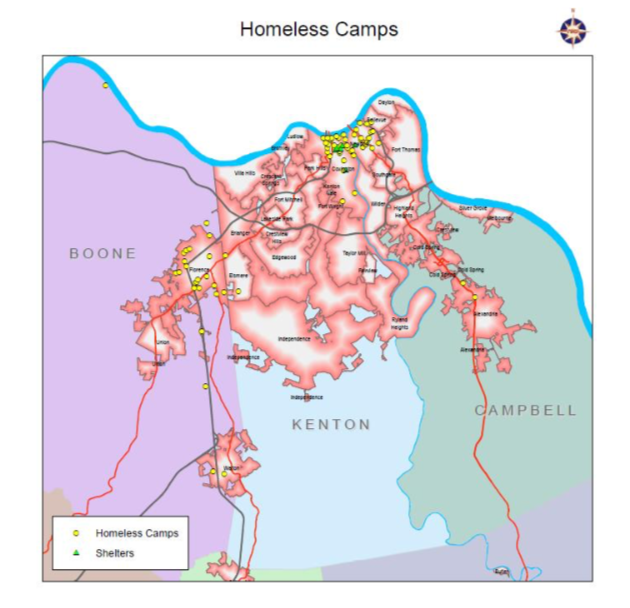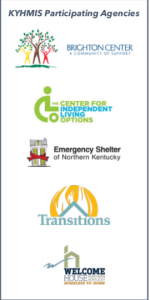NKyTribune staff
In early 2018, Kenton County, Judge/Executive Kris Knochelmann asked Candace McGraw, CEO of the Cincinnati/Northern Kentucky International Airport (CVG), to convene a broad-based working group to examine the issue of homelessness in Northern Kentucky.

Kenton County Judge/Executive Kris Knochelmann, left, asked CVG CEO Candace McGraw to convene a working group to examine the issue of homelessness in the region. Findings and recommendations were released earlier this month.
The initial charge of the group was to explore the condition of the unsheltered homeless (as opposed to other definitions and categories of individuals experiencing homelessness), as well as to improve the quality and scope of data collected on the unsheltered homeless population.
“Candace and the working group released their initial report on unsheltered homeless, based on new data collected that represents the deepest study of this population ever completed in Northern Kentucky,” Knochelmann said. “I know this data, and the follow-up recommendations, will help our region develop a better approach to this important issue.”
The work led to a strong partnership with the Kentucky Housing Corporation (KHC), which administers U.S. Housing and Urban Development (HUD) programs for the “balance of state” in Kentucky. Data collection focused on additional questions/elements included in the Kentucky Homelessness Management Information System (HMIS) at KHC. Client-level information included in the data is taken from emergency shelters, transitional housing, rapid re-housing, and permanent supportive housing projects for the KYHMIS participating agencies.
McGraw said that in business, good data drive strong and informed decision-making and the same holds true for public policy. It is especially necessary when confronting homelessness and housing issues.
“The working group that Judge/Executive Kris Knochelmann asked me to convene identified gaps in data collection and looked to create efficiencies in data intake,” McGraw said. “Thanks to the leadership of our local non-profit service providers and other key partners, like the Kentucky Housing Corporation, we now have a more solid data set that demonstrates that homelessness is a regional challenge that requires regional attention and leadership to address.”
The data collection and findings do not include information from the following agencies that do not participate in KYHMIS, nor do they capture sheltered or unsheltered persons who never accessed a KYHMIS project.
• Women’s Crisis Center Emergency Shelter
• Family Promise Emergency Shelter
• Fairhaven Rescue Mission
Beginning on July 1, 2018, clients served in the participating KYHMIS partner projects/agencies were asked to provide responses to three new data points (additional to basic demographic data, etc.).
• County, City, and State of Last Stable Home
• Date of Last Stable Housing
• City and State of High School
The key observations and findings shared here are reflective of one (1) full year’s data being collected on the unsheltered homeless population in Northern Kentucky using these methods.
During this period, at least 1,530 individuals experienced unsheltered homelessness in the three-county Northern Kentucky region. Seventy-seven (77) percent of these individuals were age 18 or older, while 349 clients were children or reported no age.
These figures represent 829 households.
The data lead to three key findings:
1. While the unsheltered homeless in Northern Kentucky are mostly white, non-Hispanic, there is a mix of men and women, adults and children, who were served.
2. More than half of clients originally reported their last stable home to be Boone, Campbell, or Kenton Counties in Kentucky. The single-largest city that clients reported was their last stable home was Covington, Kentucky, but other Kentucky cities, such as Florence, Newport, and Erlanger, were originally home to many clients served. A significant source of the population served also reported stable housing last in Cincinnati or Ohio.
a. The identification of the city in which the respondent attended high school was asked to drill deeper into the location in which the respondent was raised. While 83 percent of adults provided a response to this question, over 50 percent of those responses indicated a high school in Cincinnati or Covington. However, it is accurate to report respondents are “originally from” all parts of Northern Kentucky and beyond, as many states were also represented in the answers.
3. These data show that the issue of homelessness is wide-reaching: individuals and families from across Northern Kentucky struggle with homelessness, and some of those have not had stable housing for many years while others have only recently (or for a short time) struggled with homelessness.

Shelter provider locations are marked by a green triangle. The yellow circles are approximate locations of reported or known homeless camps in the three-county Northern Kentucky area. *Source: Report on the Unsheltered Homeless in Northern Kentucky July 2018 – June 2019 Northern Kentucky Homelessness Working Group (click to enlarge).
Based on data collected by HMIS partners in Cincinnati, Ohio, for the reporting period of January to December 2018, HMIS providers there served 10,160 clients (over six times as many as Northern Kentucky during a 12- month period—although different reporting periods noted). In that time, in Cincinnati, 472 or 5 percent of the total clients served reported a ZIP code in Boone, Campbell, or Kenton Counties as their last permanent ZIP code.
Boone County Judge/Executive Gary W. Moore said issues of chronic homelessness and those who are precariously housed in the region affect the most vulnerable citizens in its counties, cities and schools.
“Working together to create a strategic, focused plan to combat homelessness, we can have a positive impact on the lives of our citizens while improving quality of life and enhancing the region’s workforce,” Moore said. “I am extremely grateful to Candace McGraw, her working group and to all those individuals and agencies that are dedicated to working together to see real progress in preventing and addressing homelessness in the region.”
In Northern Kentucky, 213 of 996 (21 percent) reported their last stable housing outside of Kentucky; of those 213, 165 reported an Ohio ZIP code, so the proportion of the population thought to be originating in Kentucky but served in Ohio surpasses the converse of those Ohioans served in Kentucky.
Campbell County Judge/Executive Steve Pendery said most people go on about their busy lives without noticing things like homelessness.
“When people do notice, in the beginning there is little chance they have a clue about the dimension of the problem, its root causes, who among us is affected, and the effects on all the rest of us. It is a matter of great complication,” Pendery said.
“Without good information, even those who are aware and highly motivated to help have trouble being effective. The working group Candace McGraw is leading has gone a long way toward developing data that offers a clarity and focus around the problem that will make it much easier to devise, test and adjust solutions regionally. They are offering hope for people for whom hope is in short supply.”
It is worth reiterating a caveat that the July 2018 – June 2019 data collection may not include unsheltered homeless individuals or households who did not participate in a formal HMIS program. Clients, such as those served by street outreach programs, would not necessarily be counted in these totals.
Further, since this reporting period was the first year in which some of the participating agencies asked these questions, and because adoption and accurate questioning and recording of responses may have been slow to roll out, the reported figures are likely to experience some deviation from actual numbers.
RECOMMENDATIONS & NEXT STEPS
In analyzing these data, the Northern Kentucky Homelessness Working Group has developed the following findings and recommendations for action.
1. Data should inform decision-making in public policy, helping to drive the allocation of resources. Any agency or provider serving homeless populations should continue to make strong efforts to collect information for aggregate regional reporting, while prioritizing client confidentiality and relevant privacy restrictions.
2. Gaps exist in the data collection for (1) certain geographies and (2) certain populations. The Northern Kentucky region should work with service providers and others to overcome these gaps. Additionally, work should be done across state lines, at least in terms of data sharing, to look at the unsheltered homeless across the Cincinnati/Northern Kentucky region.
3. Data should be gathered and reviewed on a systematic basis. Those data should be shared regularly with the service providers and community. The three Northern Kentucky counties should hire a regional coordinator (or otherwise designate a neutral third party) to continue the work begun here: validate data, report findings, and make policy recommendations to public agencies for how to address the unsheltered homeless.
4. While a coordinator would determine a full work plan, we suggest the most immediate issues to address would include the following.
a. Encourage public bodies across the region to do more to support homeless populations, to examine various ways to support service providers, and to prioritize funding for tools that are demonstrated to work in bringing the unsheltered homeless back into stable housing
b. Address recidivism in the unsheltered homeless population
c. Examine funding of homelessness service providers and ensure that local public allocations are
consistent with desired outcomes
5. Once a coordinator is in place, a study should be commissioned to look at longer-term policy issues.
The coordinator would identify foundations and other agencies that could potentially fund such a study.

This figure shows the states and most prominent Kentucky counties where clients reported their last stable residence. These data only include adult respondents (not clients who are children) and do not include 185 respondents who did not provide data for this field. *Source: Report on the Unsheltered Homeless in Northern Kentucky July 2018 – June 2019 Northern Kentucky Homelessness Working Group (click to enlarge).
Knochelmann said when he became Judge/Executive five years ago, his first thought was that he wanted no one to die on the streets of Kenton County for lack of a warm place to be safe in the depths of winter. In the time since, he says he has come a long way in understanding the nearly 2,000 unsheltered homeless living in the community.
“We can do better in keeping them safe, and in helping them become productive members of our community,” Knochelmann said. “I deeply appreciate the work of Candace McGraw and the working group because, with data and facts, we can do a better job of helping the unsheltered homeless put their lives back together. The new year will be an important one in addressing this issue, and I hope others in the community will join us in this effort.”
Contact the Northern Kentucky Tribune at news@nkytrib.com
























